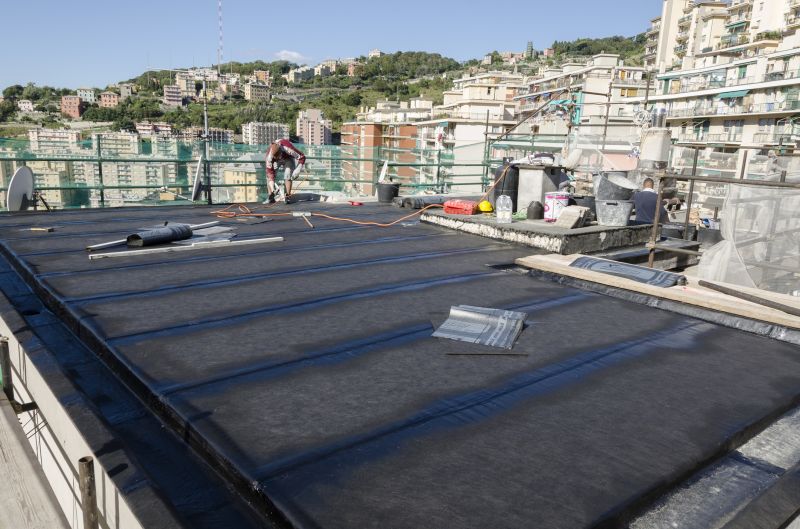Leading Products For Roof Tarping And Leak Repairs You Can Trust
Discover top-rated solutions designed to effectively seal leaks and protect your roof during emergencies or repairs.
 When addressing roof leaks and temporary repairs, having reliable products on hand is essential to prevent further damage and protect property. Roof tarping and leak repair supplies are designed to provide quick, effective solutions that can be applied in emergency situations or for short-term fixes. These products come in various forms, materials, and sizes to accommodate different types of roofs and leak scenarios. Proper selection and application are crucial to ensure that the repair holds until a permanent fix can be implemented.
When addressing roof leaks and temporary repairs, having reliable products on hand is essential to prevent further damage and protect property. Roof tarping and leak repair supplies are designed to provide quick, effective solutions that can be applied in emergency situations or for short-term fixes. These products come in various forms, materials, and sizes to accommodate different types of roofs and leak scenarios. Proper selection and application are crucial to ensure that the repair holds until a permanent fix can be implemented.
Top Overall Option
Heavy-Duty Waterproof Roof Tarp
A heavy-duty waterproof roof tarp offers a versatile and durable solution for covering damaged roof areas. Made from thick polyethylene or similar materials, it provides excellent water resistance and UV protection. Its reinforced edges and grommets facilitate secure fastening, making it suitable for emergency coverage or temporary repairs in various weather conditions. Properly installed, it can help prevent water intrusion until a permanent repair can be made.
Types of Products For Roof Tarping And Leak Repairs
Polyethylene Roof Tarps
Heavy-duty polyethylene tarps designed for outdoor use, offering waterproof protection and UV resistance.
Vinyl Roof Tarps
Flexible and durable tarps made from vinyl, suitable for various weather conditions and heavy-duty applications.
Tarp Grommets and Fasteners
Reinforced eyelets and fasteners used to secure tarps tightly over damaged roof areas.
Roof Sealant and Caulking
Specialized sealants formulated to fill small cracks and leaks on roofing surfaces.
Roof Repair Tape
High-adhesion tapes designed to seal leaks and cracks on different roofing materials.
Roof Patching Kits
Complete kits that include patches, sealants, and tools for quick repairs.
Asphalt-Based Roof Patches
Cold-applied patches suitable for asphalt shingles and similar roofing materials.
Butyl Rubber Tape
Flexible, waterproof tape ideal for sealing around vents and flashing.
Emergency Roof Covering Sheets
Pre-cut sheets made from waterproof materials for rapid deployment over damaged areas.
Roofing Adhesives
Strong adhesives for bonding patches and repair materials securely to roofing surfaces.
Flashing Repair Tape
Specialized tape for sealing around flashing and protrusions on roofs.
Temporary Roof Covering Films
Thin, waterproof films used for quick coverage in emergency situations.
Leak Detection Dyes
Dyes that help identify hard-to-see leaks and cracks in roofing materials.
Roofing Underlayment
Protective layers installed temporarily or permanently beneath roofing materials.
Roofing Nails and Fasteners
Secure fastening options for attaching tarps and patches to roofing structures.
Popular Choices
Widely used for emergency roof protection, offering durability and waterproofing.
Popular for quick sealing of leaks and cracks on various roofing surfaces.
Commonly chosen for sealing small leaks and cracks around vents and chimneys.
Convenient for rapid deployment over damaged roof areas during storms or leaks.
Favored for their flexibility and resistance to weathering in temporary repairs.
Popular for their ease of securing tarps tightly over damaged areas.
Trusted for its waterproof sealing properties around flashing and protrusions.
Often selected for comprehensive repair needs with multiple components included.
Commonly used for asphalt shingle repairs and small cracks.
Popular for bonding patches and repair materials securely.
Used frequently to locate elusive leaks in roofing systems.
Chosen for rapid coverage in emergency leak situations.
Selected for added protection beneath shingles or tiles temporarily.
Essential for securing tarps and patches firmly to roof structures.
Roof tarps are among the most versatile options for covering damaged areas. They are typically made from durable, waterproof materials that resist tearing and UV degradation. When choosing a tarp, factors such as size, thickness, and UV resistance should be considered to match the specific needs of the roof and environmental conditions. In addition to tarps, sealants and patching compounds play a vital role in sealing small leaks and cracks, providing an extra layer of protection against water intrusion.
For more targeted repairs, products like roof repair tapes and adhesives are useful. These materials adhere strongly to various roofing surfaces and can be used to seal around vents, chimneys, and flashing. Repair kits that include multiple components—such as patches, tapes, and sealants—offer a comprehensive solution for addressing different types of damage. It is important to follow manufacturer instructions carefully to ensure proper application and maximum effectiveness. Regular inspection and maintenance of roof repairs can help extend the lifespan of the fix and minimize potential damage from weather events.
Key Buying Considerations
- Material durability and resistance to tearing or UV damage
- Appropriate size and coverage area for the damaged section
- Weather resistance, including waterproof and wind-resistant features
- Ease of installation and securing options such as grommets or fasteners
- Compatibility with existing roofing materials and surfaces
- Thickness or gauge of the tarp or repair material for added strength
- Adhesion properties of tapes and sealants for effective sealing
- Flexibility and adaptability to various roof shapes and angles
- Availability of repair accessories like patches, fasteners, and tools
- Shelf life and storage considerations for emergency preparedness
- Cost-effectiveness relative to the extent of damage and repair needs
- Ease of removal or replacement if needed in future repairs
- Manufacturer instructions and recommended application procedures
- Environmental exposure factors such as UV, wind, and temperature variations
- Local weather conditions and likelihood of severe storms or heavy rain
